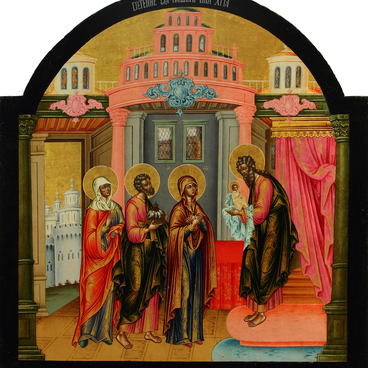The Holy Mother Gracious Heaven as an iconographic type is based on John the Theologian’s vision. According to legend, the Virgin Mary appeared before him in an oval-shaped sunny halo, mandorla. In such icons, the Holy Mother is portrayed whole-length with the infant Christ in her left arm and surrounded by oval-shaped radiance called “mandorla”. Russia’s first Gracious Heaven icon dates back to the 14th century. It was brought to Moscow by Sophia, the wife of Grand Prince Vasily I and the daughter of Vytautas, Grand Duke of Lithuania. The icon was kept in Smolensk, and in the 17th century royal icon painters made a precise replica. Since then, Holy Mother icons and variations of that iconographic style were often painted in monastery studios and peasant workshops.
1 / 2
Holy Mother Gracious Heaven
Время создания
Late 18th century
Размер
116.2х70.4 cm
Техника
Wood, tempera, gilding
Коллекция
Выставка
5
Открыть в приложении#1
Unknown Author
Holy Mother Gracious Heaven
#2
#3
About icon
#4
The Holy Mother Gracious Heaven of the Rybinsk Museum Reserve collection was made by old believer icon painters of the city of Romanov-Borisoglebsk, now Tutayev, in the late 18th century.
That was the prime time of the icon painting school in the city of Romanov-Borisoglebovsk in the Volga region — the so-called ‘Romanov style’. That nobly refined icon painting tradition was distinguished by detailed development of subjects and fine execution. The Romanov artists made both major pictures and miniatures. In a palm size icon they managed to place several scenes from the life of a saint. They used subdued and blanched colours, like mint or grass green and light pink, and gilding. Romanov icons were typically ordered by wealthy industrialists and merchants. The ‘Romanovites’ transformed West European painting techniques in the spirit of old Russian icon painting traditions.
That was the prime time of the icon painting school in the city of Romanov-Borisoglebovsk in the Volga region — the so-called ‘Romanov style’. That nobly refined icon painting tradition was distinguished by detailed development of subjects and fine execution. The Romanov artists made both major pictures and miniatures. In a palm size icon they managed to place several scenes from the life of a saint. They used subdued and blanched colours, like mint or grass green and light pink, and gilding. Romanov icons were typically ordered by wealthy industrialists and merchants. The ‘Romanovites’ transformed West European painting techniques in the spirit of old Russian icon painting traditions.
#5
The artists painted the Holy Mother in an environment of her symbols mentioned by the Old Testament. In the left-hand part of the picture, there is a mirror, a censer, the blossoming staff of Moses’ elder brother, Aaron, the tables of the covenant with the 10 commandments, and the arc in which they were kept. To the right of the Holy Mother, one sees a burning candle, higher up a vessel for manna, the amaranthine flower, and a shut gate. The heads of the Theotokos and the child Christ are crowned to mark their majesty.
#6
The halos was covered with leaf-gold, and the clothing was painted in “gold blanche” strokes, an icon painting method where the best lit or outstanding parts of the body are marked with gold strokes rather than white paint.
The museum collection received the icon from the Rybinsk Cathedral of Transfiguration of Our Saviour. In 2005, the museum experts restored the icon to its original state.
The museum collection received the icon from the Rybinsk Cathedral of Transfiguration of Our Saviour. In 2005, the museum experts restored the icon to its original state.
#7
Rybinsk Museum Reserve
читать дальшескрыть
00:00
00:00
1x
Holy Mother Gracious Heaven
Время создания
Late 18th century
Размер
116.2х70.4 cm
Техника
Wood, tempera, gilding
Коллекция
Выставка
5
Открыть в приложении
Поделиться

